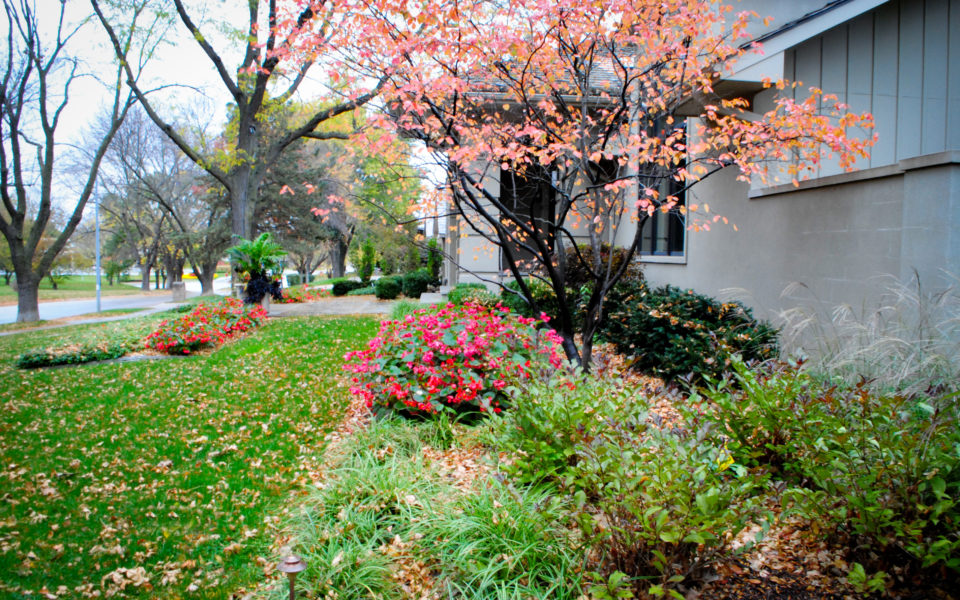Fall Landscape Tips and Checklist
Leaves are dropping, flowers are fading, and the weather is changing rapidly. It’s fall in Omaha again. And as morning dew turns to frost, it is not only a time to clean up the landscape, it’s time to prepare it for the next season. Here are 12 quick tips for ensuring your landscape remains healthy and beautiful now and into the future.
1. Clean up Fallen Debris and Clear Annuals After First Hard Frost
Left-over leaves and spent annuals in planting beds can host disease and pests that can persist into the spring. Remove diseased/sick foliage first and dispose of them separately. It is important to clear these out particularly around roses which are susceptible to fungus.
2. Cut perennials to the ground. Divide overgrown perennials and tuberous plants
While perennials provide excellent winter cover and food for local wildlife, you don’t necessarily want animals that close to your home. Unless you want to provide habitat, cut the perennials to the ground after the first hard frost. If your perennials or hostas have grown a little beyond their intended space, dig them up, divide their roots and move some to other areas of your property. This will promote better flowering the next year.
3. Shape spring blooming shrubs and trees
Pruning spring bloomers in the fall is not recommended as it will limit their flowering in the spring. Trim dangling outlier branches and dead branches so the plant holds a nice shape for the spring. The best time to do heavy pruning is after flowers fade in late spring or early summer.
4. Cut back and train summer bloomers
Most summer blooming shrubs (such as roses) flower from new growth that occurs in the spring. Fall is a great time to prune for the shape you want them to bloom next summer. We like to cut landscape roses back to 2′ in the fall and then cut them down to 4-6″ in the spring so they grow back tight and bushy with lots of flowers. Vines like Sweet Autumn Clematis should be cut to the ground.
5. Prune evergreens carefully
In general, pruning of evergreens is best done in the spring and can be done in the summer/fall as long as there is at least a month before heavy frost. If you have to have a certain shape for the winter, remove the dead branches first and shear sparingly. Too much shearing can lead to soft new growth that will die if it doesn’t have time to harden before frost.
6. Prepare planters for winter
Terra-cotta and clay-based pots act like a sponge when soaking up water. This makes them vulnerable to freeze and thaw cycles. They should be cleaned and stored upside down in a warm place. Wood, cast iron, polyurethane, fiberglass, and non-porous plastic composites can withstand the temperatures and soil may be left within them to help support winter greens and decoration.
7. Leave tall grasses standing
Tall grasses such as Carl Forester Feather Reed can provide exquisite contrast and bird cover in the winter. Cut these back in the early spring before new green growth occurs.
8. Clean out drip lines, gutters and drains.
Clogged pipes can lead to standing water in the winter that can freeze and crack pipes and gutters. Use a hose to clear out debris in pipes and an air-compressor to remove any left over moisture in drip lines.
9. Shut down water features
While water features can be left running through the winter, we do not recommend doing so as they can be damaged by power outages, ice dams, and by forgetting to add water. We recommend removing the pump and storing it indoors, submerged in a five gallon bucket of water. The water feature should also be cleared of debris at this time.
10. Trim rogue tree branches
Overstretched or dead branches can threaten the home and the health of the plant as snow weighs them down. Its best to trim these back in the fall.
11. Plant new evergreen shrubs and spring bulbs
Planting new evergreen shrubs in the fall will give their roots time to develop and preparation for new growth in the spring. Similarly, planting bulbs in the late fall will bring up healthy blooms in the spring.
12. Clean tools and store for the winter
Leftover debris on tools can cause tools to wear out, but it can also spread disease into the spring if diseased plantings were cut in the fall. It is important to keep these cleaned and stored.
Need help preparing your landscape for winter? Our team can provide all your landscape needs at a reasonable price. Breaking Ground has been designing, building and maintaining landscapes throughout the Omaha, Gretna, Elkhorn, Fremont and Bennington area for more than 15 years. You can reach us at 402-779-4444.
[gravityform id=”1″ title=”true” description=”true”]

